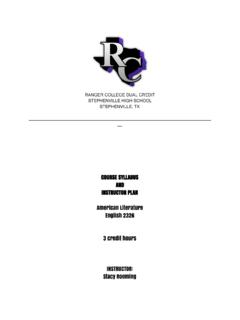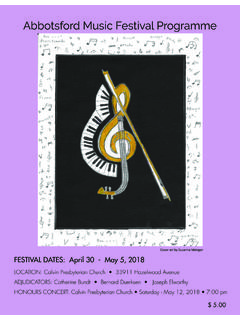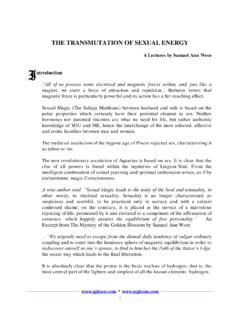Transcription of How to Play Chopin?
1 how to play chopin ? Part 6: Chopin's waltzes1. By Prof. Regina Smendzianka F. CHOPIN WROTE some2 20 Waltzes in the period from 1825 to 1847. The Polish edition of "The Complete Works of F. Chopin"3, edited by I. J. Paderewski, contains only 17 Waltzes. This collection is supplemented by the 1965 publication of two "forgotten" Waltzes, E flat major (1840) and A minor (1847/8) .4. The gradual development of the Chopin Waltz form, spread over more than two decades, can be divided into three periods: 1. The "Warsaw" Waltzes, which Chopin wrote between 1827 and 1830, before leaving Poland for good: Two Waltzes without opus numbers: A flat major and E flat major, written into Emilia Elsner's album.
2 D flat major Op. 70 no. 3; E major, without opus number, B minor Op. 69 no. 2; E minor, without opus number;5. 2. The Waltzes from the early Parisian period written between 1831-1835 (finally edited in 1838): E flat major Op. 18; A minor Op. 34 no. 2; A flat major Op. 34 no. 1;. A flat major Op. 69 no. 1; G flat major Op. 70 no. 1. 3. The Waltzes written in the mature period, 1838 to 1847/8: F major Op. 34 no. 3; A flat major Op. 42; E flat major "Forgotten", without opus number; F minor Op. 70 no. 2; D flat major Op. 64 no. 1; C sharp minor Op. 64 no. 2;. A flat major Op. 64 no, 3; A minor " Forgotten", without opus number.
3 In Chopin's early Waltzes, especially in his strict use of the time/ rhythm patterns, we can see a close resemblance to the authentic Viennese waltz model. These youthful Waltzes were also inspired by the work of earlier Polish composers (Maria Szymanowska, Michal Kleofas Oginski, Karol Kurpinski, Franciszek Lessel, Antoni Radziwill and others), as Chopin stylized the Viennese waltz and the Polish city waltz in the same manner. It has to be noted that mazurka elements are evident in Polish waltzes of the pre-Romantic period. The similarities between the rhythmic, melodic and movement patterns of the two dances make it hard to tell them Chopin, too, employed mazurka patterns in his Waltzes: Rhythmic patterns: Waltzes: E flat major Op.
4 18 - bars 3, 4, 22 and following; bars 47, 48. A flat major Op. 34 no. I - bars 1, 5, 33 and following A flat major Op. 64 no. 3 - bars 74, 80, 84. Melodic/movement patterns: Swinging (like a pendulum) movement: Waltz A flat major Op. 69 no. I - bars 33, 34. Anchor-like movement: Waltz E flat major Op. 18 - bar 5 and following Revolving (like windmill blades). Waltz F major Op. 34 no. 3 - bar 17 and following D flat major Op. 64 no. I - bar I and following The Chopin Waltz form, just like that of the earlier composers, is confined within the reprise However, Chopin's talent is by far greater than that of his Polish predecessors, and so is his creative imagination and sophisticated technique.
5 Thanks to these qualities he gave the Waltz an artistic status; his Waltz is a dance poem freed from its former utility function. Chopin also had the edge over his contemporaries. Writing his Waltzes, he took advantage of the greater possibilities offered by the then-modern instrument to add a virtuoso element to this dance form, including octaves leaps, glissandos, passages and figurations based on the wide range of piano registers. In this way he gave this dance the qualities typical of the brillante style. Furthermore, Chopin used a whole range of emotions reflecting his personal feelings thanks to which his Waltzes have their own unique character.
6 The richness of expression and the variety of moods reflect the vividness of the composer's imagination. At the same time, the lyrical quality of the Waltz, along with a strong emphasis of the cantilena element, offers an insight into his intellectual abilities. As regards the texture of Chopin's Waltes, in these generally homophonic pieces we can find examples of polyphony: (A flat major Op. 42; D flat major Op. 70 no. 3 (bars 1- 16);. A flat major Op. 64 no. 3 - Trio). However, typical of this polyphony is that it smoothly changes to the homophonic-type texture (a characteristic trait of Chopin's polyphony.)
7 Chopin's Waltzes provide interesting instances of polymetrics: F major Op. 34 no. 3 (bars 17- 48); D flat major Op. 64 no. I - bars 52, 53; C sharp minor Op. 64 no. 2 - bars 92, 93; A flat major Op. 42 (bars 9-40). The Chopin Waltz harmonics' richness comes from changes in the keys used in individual periods (themes), the deceptive cadences, chromatic scale and exquisite modulations. This develops together with Chopin's composing technique used for writing other pieces. Special notice should be given to the remarkable "mobility" of the modulation in the last Waltz (A flat major Op. 64 no. 3). The harmony of this Waltz displays some qualities of the "last" Chopin.
8 This "bird's eye view" of Chopin's entire Waltz cycle, while far from presenting a complete picture of the form and content of these pieces, can give us some idea about the range of the interpretive means which are required for playing these miniature pieces. It is important that the interpreter of Chopin's Waltzes not only clearly presents the character and mood of each piece, but also employs distinctly different means of expression, depending on when (in which period). they were written. The means used for bringing out the sentimental style of the youthful Waltzes cannot be employed for playing the mature Waltzes.
9 Similarly, the tools of interpreting Chopin's late and last Waltzes, when used to perform the simple and straightforward pieces from his early period, may dangerously distort them into musical caricatures. It might also seem that a practical knowledge of the waltz and the ability to "perform" it in the ballroom is the simplest way to understand and feel its unique atmosphere, charm, elegance, and conventional distance. A word of caution, however: the above qualities of the waltz are, in the case of Chopin, interspersed with fragments of sincere lyrical expression, sometimes with bitter reflection, while at other points, with unrestrained joy and gaiety.
10 The kaleidoscopic pattern of moods occurring in individual periods (themes) of Chopin's Waltzes and the contrasting climate and nature of the interwoven fragments require that the interpreter has enough ability, mental flexibility and iron intellectual discipline to cope with these problems and still to create the impression of light social entertainment. English translation: Jerzy Ossowski _____. 1. The waltz (Walzer), initially a folk dance originated in southern Germany (1750), was danced in slow 3/4 and 3/8 time by couples in clogs or hobnailed boots on the lawn in front of the village inn or in the town square.










